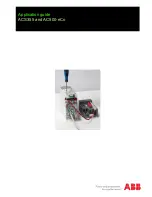
Page 10 of 90
CCT24
BaseSlotSize
parameters and the number of registered radios. The
MinPacketLength
and
TxTimeout
parameters operate in a remote in the same manner as in the base.
2.6 RF Transmission Error Control
The CCT24 supports two error control modes: automatic transmission repeats (ARQ), and redundant
transmissions for broadcast packets. In both modes, the radio will detect and discard any duplicates of
messages it receives so that the host application will only receive one copy of a given message. In the
redundant transmission mode, broadcast packets are repeated a fixed number of times based on the
value of the
ARQ_AttemptLimit
parameter. In ARQ mode, a packet is sent and an acknowledgement is
expected on the next hop. If an acknowledgement is not received, the packet is transmitted again on the
next available hop until either an ACK is received or the maximum number of attempts is exhausted. If the
ARQ_
AttemptLimit
parameter is set to its maximum value, a packet transmission will be retried without
limit until the packet is acknowledged. This is useful in some point-to-point cable replacement applications
where it is important that data truly be 100% error-free, even if the destination remote goes out of range
temporarily.
2.7 Transmitter Power Management
The CCT24 includes provisions for setting the base transmit power level and the remote maximum trans-
mit power level with the
TxPower
parameter. CCT24 networks covering a small area can be adjusted to
run at lower transmitter power levels, reducing potential interference to other nearby systems. Radios that
are located close to their base can be adjusted to run at lower maximum power, further reducing potential
interference. Base units transmit at the fixed power level set by the
TxPower
parameter. Remotes and
routers automatically adjust their transmitter power to deliver packets to the base at an adequate but not
excessive signal level, while not transmitting more power than set by their
TxPower
parameter. Remotes
and routers make transmitter power adjustments using the strength of the signals received from the base
and the base transmitter power setting, which is periodically transmitted by the base. The automatic
transmit power adjustment is enabled by default, but can be disabled if so desired. Refer to Section 4.2.1
for details.
2.8 Network Configurations
The CCT24 supports four network configurations: point-to-point, point-to-multipoint, peer-to-peer and
tree-routing. In a point-to-point network, one radio is set up as the base and the other radio is set up as a
remote. In a point-to-multipoint network, a star topology is used with the radio set up as a base acting as
the central communications point and all other radios in the network set up as remotes. In this configura-
tion, each communication takes place between the base and one of the remotes. Peer-to-peer communi-
cations between remotes using the base as a relay is also supported, as discussed in Section 2.8.3.
Tree-routing networks can retransmit messages through one or more routers, greatly expanding the area
that can be covered by a single CCT24 system, as discussed in Section 2.8.4.
2.8.1 Point-to-Point Network Operation
Most point-to-point networks act as serial cable replacements and both the base and the remote use
transparent mode. Unless the
MinPacketLength
and
TxTimeout
parameters have been set above their
default values, the base will send the data in its transmit buffer on each hop, up to a limit controlled by the
BaseSlotSize
parameter. In transparent mode, if the base is buffering more data than can be sent on one
hop, the remaining data will be sent on subsequent hops. The base adds the address of the remote, a











































